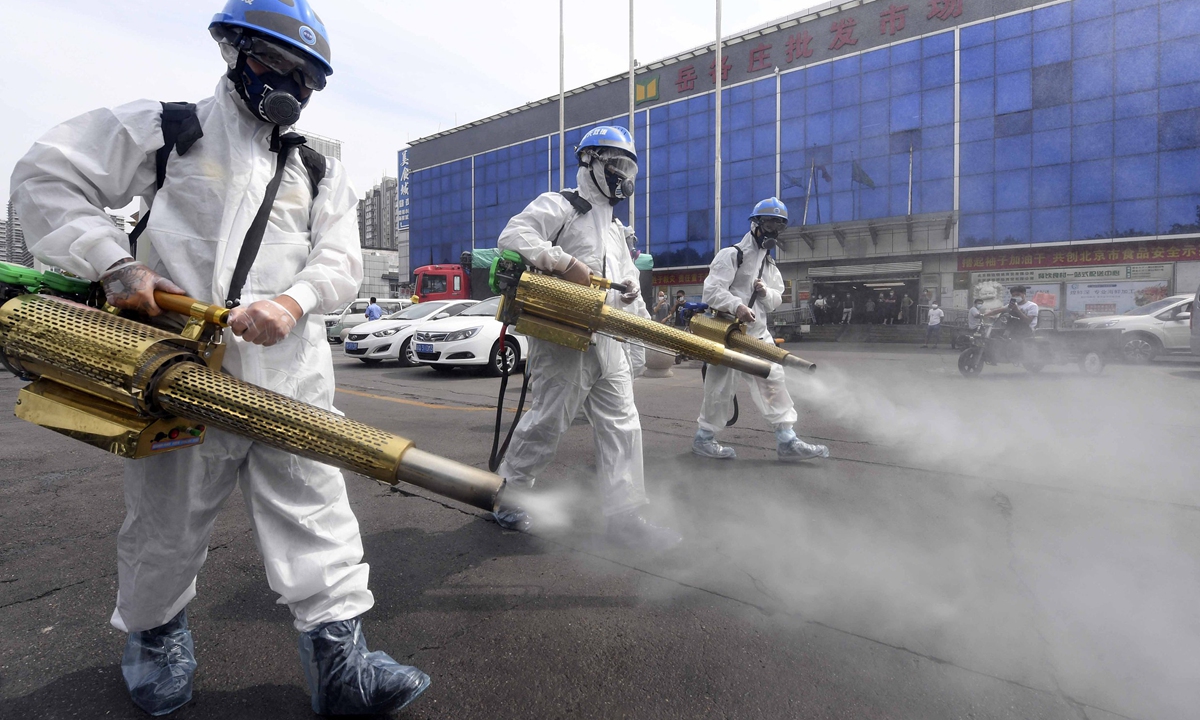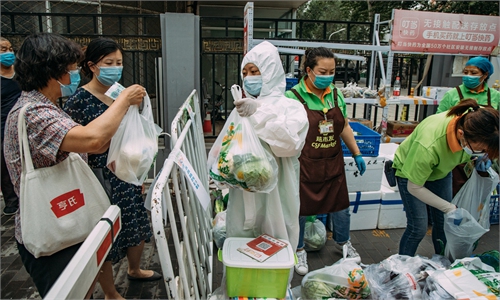
Volunteers from the Beijing Blue Sky Rescue Team spray disinfectant in Yuegezhuang wholesale market in Fengtai district, Beijing. The market is about 12 kilometers from the Xinfadi market, which is linked to the recent COVID-19 outbreak in the capital city. Photo: people.cn
A large amount of samples taken from the Xinfadi market in Beijing tested positive for coronavirus. Beijing reported 183 infections within a week, all related to Xinfadi. This propelled experts to speculate that a super spreader may have existed, and finding the spreader is vital to containing the virus in Beijing.
Since the second outbreak flared up at Xinfadi, virologists from China's CDC have visited the now closed market three times - on June 14, 15 and 17 - and announced a groundbreaking discovery, according to a detailed epidemiological survey published on the website of the Communist Party of China (CPC) Central Commission for Discipline Inspection (CCDI) on Friday.
More than 200 samples from the underground seafood market were initially collected, including a salmon throat swab, and many of the samples tested positive for the virus. The second investigation saw virologists collect samples 2 kilometers away from the market, with many results also coming back positive. The third investigation targeted the water system, including water in which fish was kept. Those samples are currently undergoing testing.
"Many positive samples show this place is severely contaminated by the virus," said Wu Guizhen, Party secretary of the National Institute for Viral Disease Control and Prevention at the Chinese Center for Disease Control and Prevention.
Beijing reported around 200 infections within a week, and all were linked to the Xinfadi market - a sign of a possible super spreader in the market, Yang Zhanqiu, deputy director of the pathogen biology department at Wuhan University, told the Global Times.
If a super spreader does exist, local authorities have to do enough nucleic acid tests, Jin Dongyan, a professor at the School of Biomedical Sciences at the University of Hong Kong, told the Global Times on Friday.
Experts said the spreader may be around those confirmed cases, or still at large. "Either way, nucleic acid tests can help identify virus concentration," Yang said.
Liu Jun, a researcher at the National Institute for Viral Disease Control and Prevention, who also participated in virus sourcing work in Wuhan, told the CCDI website there are theories as to how the virus arrived in Beijing.
Seafood products may have caused the latest outbreak after they were transported to the market via a cold chain. Another possibility is that an infected individual entered the market and spread the virus to others, Liu said.
The Chinese Center for Disease Control and Prevention published on Thursday night the genome sequence data of the coronavirus that caused the latest COVID-19 outbreak in Beijing. The data has also been submitted to the World Health Organization and the Global Initiative on Sharing All Influenza Data.
Jin said that the coronavirus genome sequencing data, together with epidemiologic investigations, could help scientists better analyze the source of the virus, like whether it's more like the virus in Europe.
It could also help scientists find out who Beijing's first patient was, so that we could determine the virus' transmission route, Jin said.



